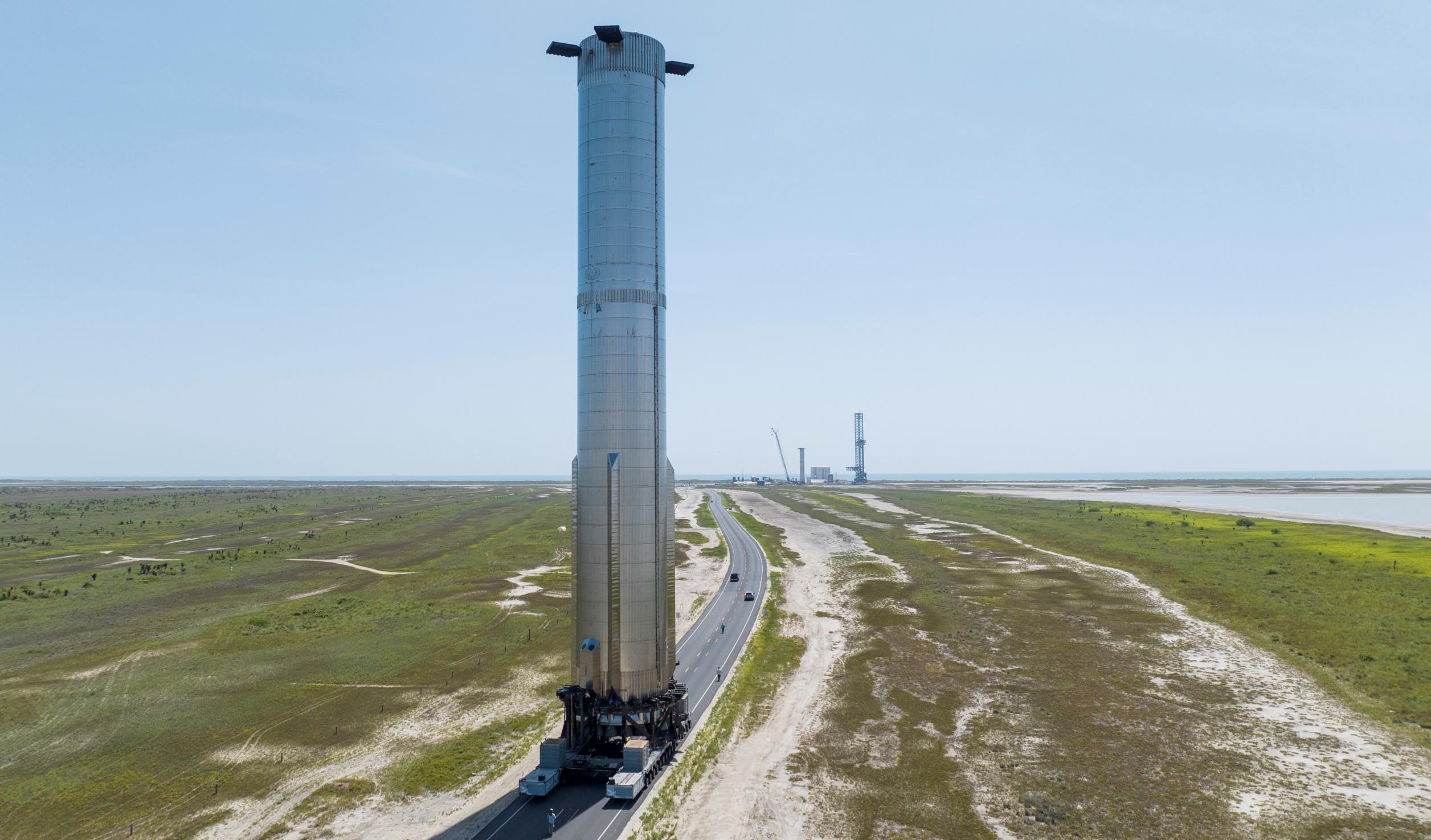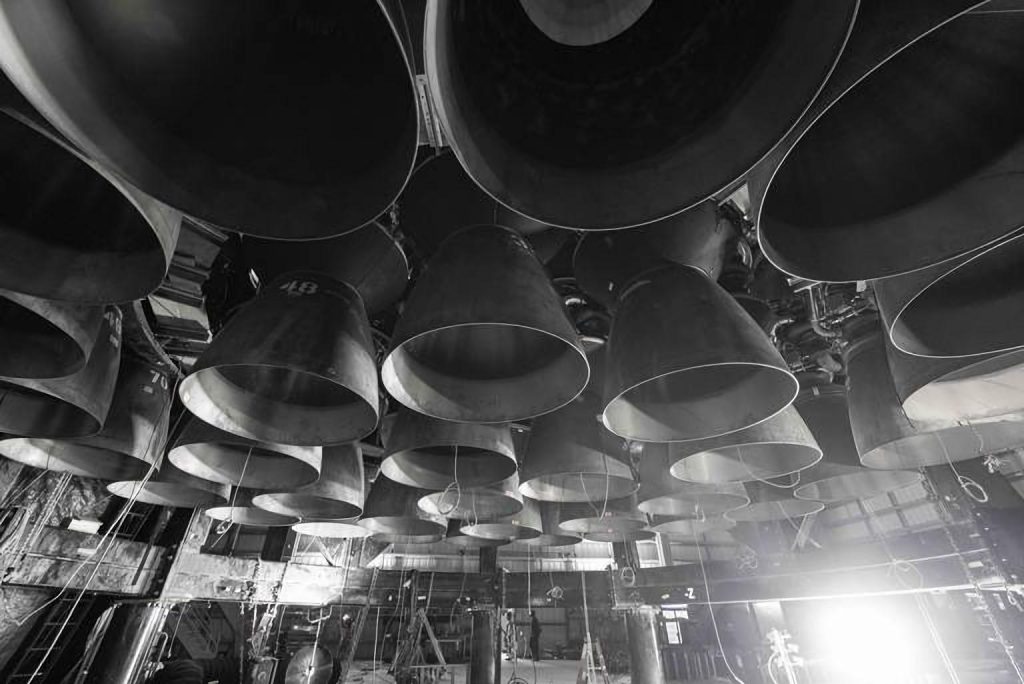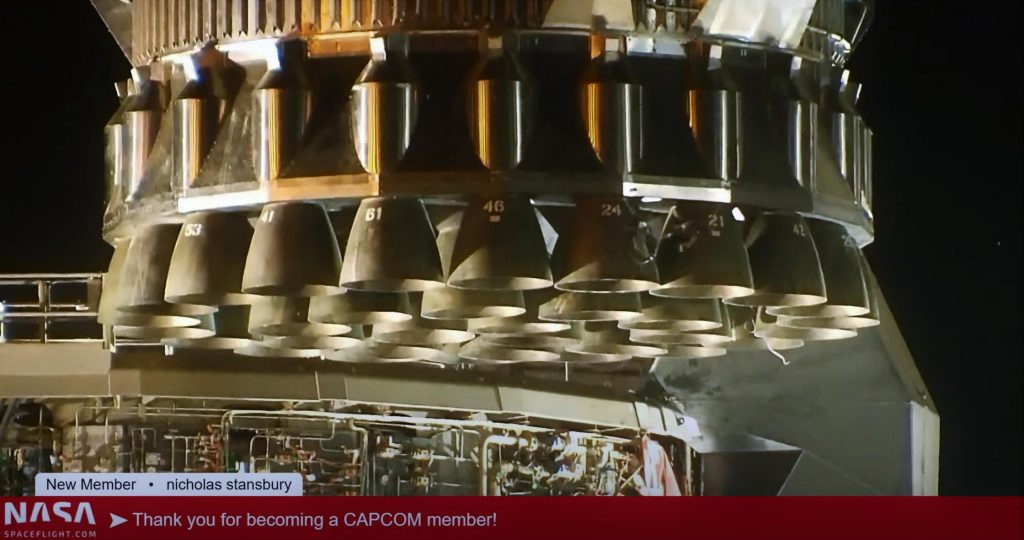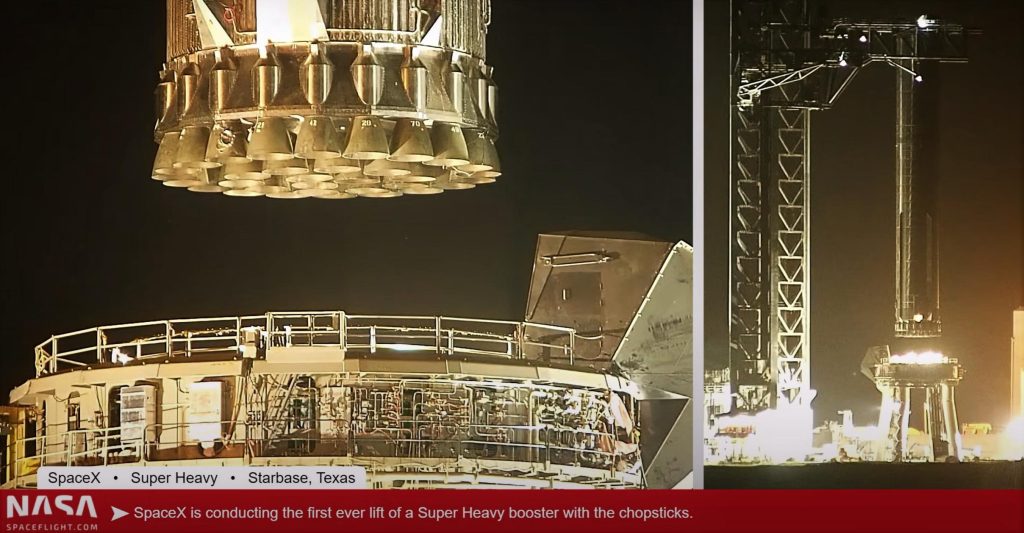

News
SpaceX installs Super Heavy booster on launch mount with giant robot arms
SpaceX has transported the most powerful rocket booster ever assembled to its Starbase orbital launch site (OLS) and used giant robotic arms to install it.
It’s not the first such trip for Starship’s Super Heavy first stage in general, nor for this specific booster, which is known as Booster 7 or B7. Booster 7 first headed to the pad on March 31st and successfully completed two major cryogenic proof tests, but was then severely damaged during a subsequent structural stress test. After a few weeks of repairs back at the factory, B7 rolled to the pad a second time and completed a third cryoproof test and returned to the factory on May 14th, where it stayed until June 23rd.
After almost six weeks of additional work, Booster 7 rolled to the launch pad for the third time – possibly its last trip.
Even Booster 7’s first rollout wasn’t unprecedented, however. In September 2021, Booster 4 – an earlier prototype with fewer engines, less thrust, and several other differences – arrived at the launch site with 29 Raptor V1 engines installed. Over the next six months, SpaceX slowly finished the booster, conducted a handful of proof tests, and eventually performed three ‘full-stack’ tests with Starship S20. For awhile, SpaceX hoped to eventually fly B4 and S20 on Starship’s first orbital launch attempt, but that plan never came close to fruition.
Booster 4 was particularly underwhelming and never even attempted a single static fire despite having all 29 of its engines fully installed and encased inside a shell-like heat shield. Thankfully, Booster 7 appears to have a much better chance of at least attempting one or several static fires, even if there’s no guarantee that it will make it through that test campaign in good enough condition to support Starship’s orbital launch debut.
SpaceX used the six weeks Booster 7 spent back in a factory assembly bay to finish installing aerocovers, surfaces known as chines or strakes, car-sized grid fins, Starlink internet dishes, and – most importantly – 33 upgraded Raptor V2 engines. Combined, Booster 7 should be able to produce up to 7600 metric tons (~16.8M lbf) of thrust – 41% more thrust than Booster 4 was theoretically capable of. Crucially, SpaceX also finished installing Booster 7’s Raptor heat shield in the same period, completing in six weeks work that took Booster 4 more like half a year.
That is likely because testing Booster 4, for whatever reason, just wasn’t a priority for SpaceX. Preparing Booster 7 for static fire testing, however, is clearly a front-and-center priority in 2022. With its heat shield and all 33 Raptors installed, Booster 7 will be ready to kick off static fire testing almost as soon as it’s installed on Starbase’s orbital launch mount.


According to CEO Elon Musk, Booster 7 will start by igniting just one or a few Raptor engines. SpaceX has never ignited more than six Raptor V1 engines simultaneously and never tested more than three engines at a time on a Super Heavy booster. That plan could have easily changed, however. Either way, Super Heavy B7 will be treading significantly new ground. Even before actual static fires begin, Booster 7 will also need to complete one or more wet dress rehearsals (WDRs), a test that exactly simulates a launch but stops just before the moment of ignition.
If SpaceX attempts a full wet dress rehearsal, in which the booster would be filled with more than 3000 tons (~6.6M lb) of liquid oxygen (LOx) and liquid methane (LCH4), it would be a first for Super Heavy and just as big of a test of the orbital launch site. Booster 7 will also need to test out its autogenous pressurization, which replaces helium with hot oxygen and methane gas to pressurize the rocket’s propellant tanks.

Several hours after Super Heavy B7 arrived (for the third time) at the orbital launch site, SpaceX used two giant arms attached to the pad’s launch tower to lift the ~70-meter (~230 ft) tall rocket onto the launch mount. While Musk says that the ultimate goal is to use those arms to catch Starship and Super Heavy out of mid-air, their current purpose is to take the place of the tall and unwieldy crane that would otherwise need to be used to lift either stage. The arms are an extremely complex solution but they do allow SpaceX to lift, install, and remove Starship stages remotely and insulate those processes from wind conditions, which cranes are sensitive to.
Once fully secured by the mount’s 20 hold-down clamps, the booster will be connected to ground systems and SpaceX can prepare B7 to start the next stage of preflight testing as early as Monday, June 27th.
Elon Musk
Tesla investors will be shocked by Jim Cramer’s latest assessment
Jim Cramer is now speaking positively about Tesla, especially in terms of its Robotaxi performance and its perception as a company.

Tesla investors will be shocked by analyst Jim Cramer’s latest assessment of the company.
When it comes to Tesla analysts, many of them are consistent. The bulls usually stay the bulls, and the bears usually stay the bears. The notable analysts on each side are Dan Ives and Adam Jonas for the bulls, and Gordon Johnson for the bears.
Jim Cramer is one analyst who does not necessarily fit this mold. Cramer, who hosts CNBC’s Mad Money, has switched his opinion on Tesla stock (NASDAQ: TSLA) many times.
He has been bullish, like he was when he said the stock was a “sleeping giant” two years ago, and he has been bearish, like he was when he said there was “nothing magnificent” about the company just a few months ago.
Now, he is back to being a bull.
Cramer’s comments were related to two key points: how NVIDIA CEO Jensen Huang describes Tesla after working closely with the Company through their transactions, and how it is not a car company, as well as the recent launch of the Robotaxi fleet.
Jensen Huang’s Tesla Narrative
Cramer says that the narrative on quarterly and annual deliveries is overblown, and those who continue to worry about Tesla’s performance on that metric are misled.
“It’s not a car company,” he said.
He went on to say that people like Huang speak highly of Tesla, and that should be enough to deter any true skepticism:
“I believe what Musk says cause Musk is working with Jensen and Jensen’s telling me what’s happening on the other side is pretty amazing.”
Tesla self-driving development gets huge compliment from NVIDIA CEO
Robotaxi Launch
Many media outlets are being extremely negative regarding the early rollout of Tesla’s Robotaxi platform in Austin, Texas.
There have been a handful of small issues, but nothing significant. Cramer says that humans make mistakes in vehicles too, yet, when Tesla’s test phase of the Robotaxi does it, it’s front page news and needs to be magnified.
He said:
“Look, I mean, drivers make mistakes all the time. Why should we hold Tesla to a standard where there can be no mistakes?”
It’s refreshing to hear Cramer speak logically about the Robotaxi fleet, as Tesla has taken every measure to ensure there are no mishaps. There are safety monitors in the passenger seat, and the area of travel is limited, confined to a small number of people.
Tesla is still improving and hopes to remove teleoperators and safety monitors slowly, as CEO Elon Musk said more freedom could be granted within one or two months.
News
Tesla launches ultra-fast V4 Superchargers in China for the first time
Tesla has V4 Superchargers rolling out in China for the first time.

Tesla already has nearly 12,000 Supercharger piles across mainland China. However, the company just initiated the rollout of the ultra-fast V4 Superchargers in China for the first time, bringing its quick-charging piles to the country for the first time since their launch last year.
The first batch of V4 Superchargers is now officially up and running in China, the company announced in a post on Chinese social media outlet Weibo today.
The company said in the post:
“The first batch of Tesla V4 Superchargers are online. Covering more service areas, high-speed charging is more convenient, and six-layer powerful protection such as rain and waterproof makes charging very safe. Simultaneously open to non-Tesla vehicles, and other brands of vehicles can also be charged. There are more than 70,000 Tesla Superchargers worldwide. The charging network layout covers 100% of the provincial capitals and municipalities in mainland China. More V4 Superchargers will be put into use across the country. Optimize the charging experience and improve energy replenishment efficiency. Tesla will accompany you to the mountains, rivers, lakes, and seas with pure electricity!”
The first V4 Superchargers Tesla installed in China are available in four cities across the country: Shanghai, Zhejiang, Gansu, and Chongqing.

Credit: Tesla China
Tesla has over 70,000 Superchargers worldwide. It is the most expansive and robust EV charging network in the world. It’s the main reason why so many companies have chosen to adopt Tesla’s charging connector in North America and Europe.
In China, some EVs can use Tesla Superchargers as well.
The V4 Supercharger is capable of charging vehicles at speeds of up to 325kW for vehicles in North America. This equates to over 1,000 miles per hour of charging.
Elon Musk
Elon Musk hints at when Tesla could reduce Safety Monitors from Robotaxi
Tesla could be reducing Safety Monitors from Robotaxi within ‘a month or two,’ CEO Elon Musk says.

Elon Musk hinted at when Tesla could begin reducing Safety Monitors from its Robotaxis. Safety Monitors are Tesla employees who sit in the front passenger seat during the driverless rides, and are there to ensure safety for occupants during the earliest rides.
Tesla launched its Robotaxi fleet in Austin last Sunday, and after eight days, videos and reviews from those who have ridden in the driverless vehicles have shown that the suite is safe, accurate, and well coordinated. However, there have been a few hiccups, but nothing that has put anyone’s safety in danger.
A vast majority — close to all of the rides — at least according to those who have ridden in the Robotaxi, have been performed without any real need for human intervention. We reported on what was the first intervention last week, as a Safety Monitor had to step in and stop the vehicle in a strange interaction with a UPS truck.
Watch the first true Tesla Robotaxi intervention by safety monitor
The Tesla and UPS delivery truck were going for the same street parking space, and the Tesla began to turn into it. The UPS driver parallel parked into the spot, which was much smaller than his truck. It seemed to be more of an instance of human error instead of the Robotaxi making the wrong move. This is something that the driverless cars will have to deal with because humans are aggressive and sometimes make moves they should not.
The Safety Monitors have not been too active in the vehicles. After all, we’ve only seen that single instance of an intervention. There was also an issue with the sun, when the Tesla braked abnormally due to the glare, but this was an instance where the car handled the scenario and proceeded normally.
With the Robotaxi fleet operating impressively, some are wondering when Tesla will begin scaling back both the Safety Monitors and Teleoperators that it is using to ensure safety with these early rides.
CEO Elon Musk answered the inquiry by stating, “As soon as we feel it is safe to do so. Probably within a month or two.”
As soon as we feel it is safe to do so.
Probably within a month or two. We continue to improve the Tesla AI with each mile driven.
— Elon Musk (@elonmusk) June 30, 2025
Musk’s response seems to confirm that there will be fewer Teleoperators and Safety Monitors in the coming months, but there will still be some within the fleet to ensure safety. Eventually, that number will get to zero.
Reaching a point where Tesla’s Robotaxi is driverless will be another significant milestone for the company and its path to fully autonomous ride-sharing.
Eventually, Tesla will roll out these capabilities to consumer-owned vehicles, offering them a path to generate revenue as their car operates autonomously and completes rides.
For now, Tesla is focusing on perfecting the area of Austin where it is currently offering driverless rides for just $4.20 to a small group of people.
-

 News5 days ago
News5 days agoTesla Robotaxi’s biggest challenge seems to be this one thing
-

 News2 weeks ago
News2 weeks agoTesla confirms massive hardware change for autonomy improvement
-

 Elon Musk2 weeks ago
Elon Musk2 weeks agoElon Musk slams Bloomberg’s shocking xAI cash burn claims
-

 News2 weeks ago
News2 weeks agoTesla China roars back with highest vehicle registrations this Q2 so far
-

 News2 weeks ago
News2 weeks agoTesla features used to flunk 16-year-old’s driver license test
-

 News2 weeks ago
News2 weeks agoTexas lawmakers urge Tesla to delay Austin robotaxi launch to September
-

 News2 weeks ago
News2 weeks agoTesla dominates Cars.com’s Made in America Index with clean sweep
-

 News2 weeks ago
News2 weeks agoTesla’s Grok integration will be more realistic with this cool feature





















